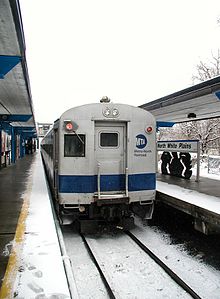This article needs additional citations for verification. (April 2018) |
| ACMU | |
|---|---|
 ACMU at the North White Plains station in 2004. | |
| In service | 1950–2004 |
| Manufacturer |
|
| Constructed |
|
| Number built |
|
| Number preserved | 4 |
| Successor | 4500 Series: M1a 4600/4700 series: M7a MP75: C3 |
| Formation | Single unit |
| Fleet numbers |
|
| Capacity | 130 |
| Operators | |
| Specifications | |
| Car length | 85 ft 0 in (25.91 m) |
| Width | 10 ft 11+1⁄2 in (3.340 m) |
| Doors | 2 vestibule doors |
| Maximum speed | 80 mph (130 km/h) |
| Weight | 114,000 lb (52,000 kg) |
| Traction motors |
|
| Power output | 400 hp (300 kW) |
| HVAC | Electric heat, air conditioning |
| Electric system(s) | 660 V DC third rail |
| Current collector(s) | Contact shoe |
| Braking system(s) | Pneumatic |
| Safety system(s) | emergency brakes |
| Coupling system | AAR |
The ACMUs (short for Air Conditioned Multiple Unit) were a series of electric multiple unit railcars built for the New York Central Railroad in three orders between 1950 and 1965. The ACMUs were intended to replace/supplement the original fleet of heavyweight MU cars, some of which dated to the start of electric operations on the New York Central. These were the first New York Central units to offer air conditioning, with sealed windows replacing the drop sash and clerestory types found on earlier cars. The initial set of 100 cars was retired in 1970, upon completion of the M1 railcar delivery, while the second and third orders, totaling 87 cars, remained in service until 2004, when they were replaced by the new M7 fleet.
An order of near-identical cars was built for the Long Island Rail Road as the MP75 class in 1963. The LIRR cars were eventually converted to non-powered push-pull coaches before being retired in the late 1990s.